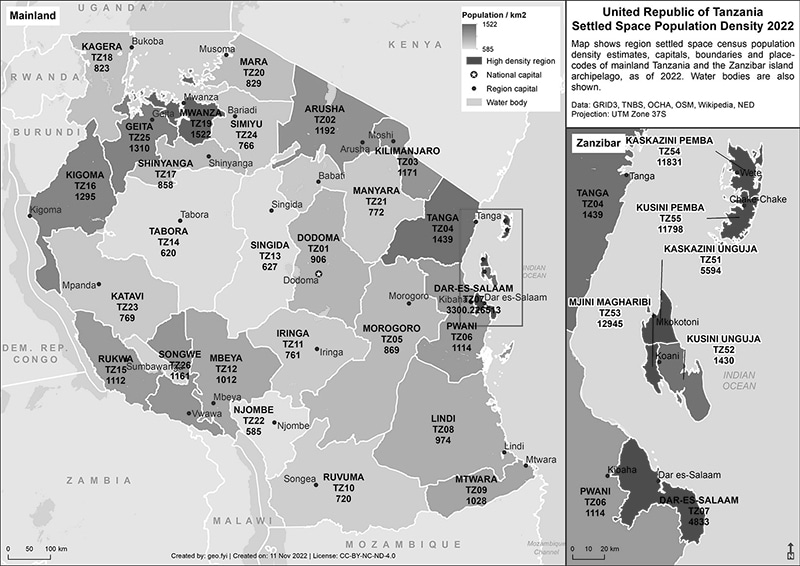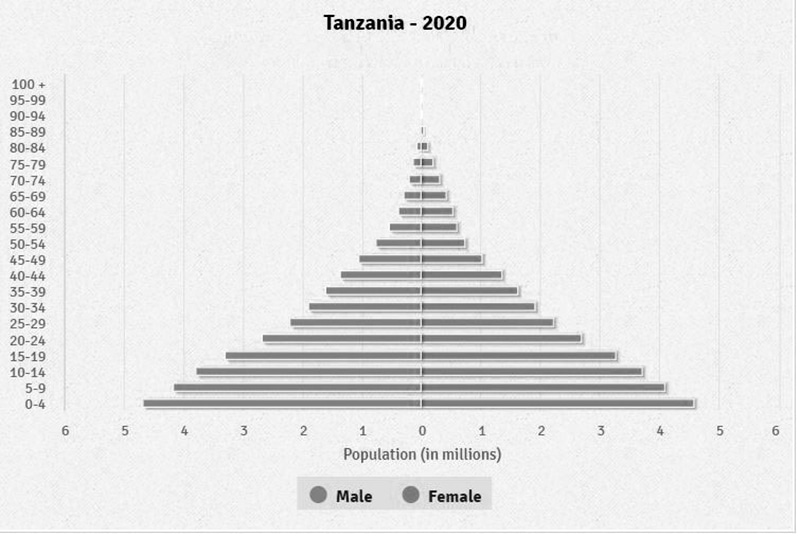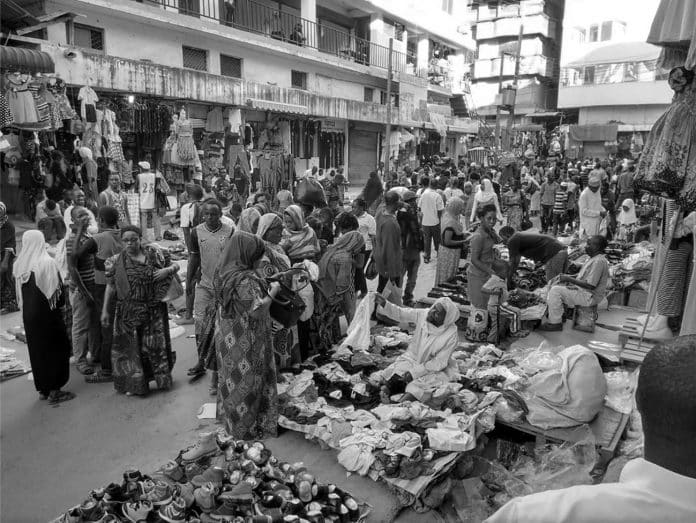A Quick Snapshot of the United Republic of Tanzania Population (Tanzanie Population)
What is Tanzania’s population? According to the 2015 revised version of the UN’s world population prospects, current population in Tanzania of 53.47 million is expected to increase by more than double by 2050.
What is the Current Population of Tanzania Expected Rate of Increase?
The current population of Tanzania will increase its yearly contribution to the global population from 1.56 million in 2015 to 2.975 million in 2050. This population increase would move Tanzania from the present 14th position with a 1.9 percent growth contribution to the 4th position with 5.5 percent in 2050, trailing Nigeria, India, and the Democratic Republic of the Congo.
For example, recent trends shows that Tanzania population 2020 was 61.7 million, which quickly grew to about 2 million people extra, as per the United Nations’ estimates, Tanzania population 2022 was about 63.3 million.
Quick Stats Pertaining to Population Tanzania
Tanzania, which currently ranks 26th on the list of countries accounting for 75.1 percent of the global population, would rank 14th by 2050, with an expected population of 137.136 million. Among other findings, the report also highlights Tanzania’s median age. The median age is expected to grow from the present 17.3 years to 22.2 years by 2050. This figure places Tanzania among the ten countries with the youngest population in the world. Furthermore, the fertility rate, which is measured as the number of children birthed by a woman, would reduce from the present 5.24 (a high fertility rate) to 3.24 by 2050. Under-five mortality and child mortality rates measured as the number of death per thousand births would improve from 51.5 and 37 to 24.2 and 19.1. Also, life expectancy at birth is expected to increase from the present 64 years to 74.2 years over the same period. The United Nations Population Fund (UNFPA) works closely with the government of Tanzania to design and implement programs related to development, reproductive health and Tanzanian population to ensure social equality, economic development and improvement in infant mortality rate and maternal health.
Other Important Facts About the Population of Tanzania Africa
Population Growth in Tanzania
The population growth rate in Tanzania has shown a rapid increase year after year. Here is a quick population growth Tanzania benchmarks to refer to in a number of years:
- Population of Tanzania 2010 – The population growth rate Tanzania experienced in this year was about 45.11 million people
- Population of Tanzania 2012 – 47.79 million
- Tanzania population 2013 – 49.25 million
- Tanzania population 2014 – 50.81 million
- Tanzania population 2015 – 52.54 million
- Tanzania population 2016 – 54.4 million
- Tanzania population 2017 – 56.27 million
- Population of Tanzania in 2018 – 58.09 million. But for further details on the population of Tanzania 2018, refer to the World Bank Tanzania population 2018
- Tanzania population 2019 – 59.87 million. For more data on population of Tanzania 2019, you can also visit population Tanzania 2019
- Tanzania population 2020 – 61.7 million. The population of Tanzania 2020 showed an increase of about 2 million people to the prior year, you can browse this link for further insights, population of Tanzania in 2020.
- Tanzania population 2021 – 63.59 million. Another 2 million increase trend continued in terms of the population of Tanzania in 2021. Checkout more data here for comparisons, population of Tanzania 2021.
- What is the population of Tanzania in 2022? – population of Tanzania 2022
- Tanzania population 2023 – 64.72 million
- Tanzania population 2050 – expected to be around 135.24 million people
- Tanzania population 2100 – Tanzania population projections shows that the country will have about 285.65 million
Some Ethnicities Total Population in Tanzania

- Indian population in Tanzania – Basing on India’s High Commission in Dar es Salaam, the estimate is about 50,000 people
- Maasai population in Tanzania
- Tanzania Shia population – about 20% of the total Muslim population in the country
- Tanzania white population – white population in Tanzania
- Tanzania Hindu population
Tanzania Cities Population
Major Regions and/or Cities in Tanzania by Population:
Here is a quick list of some of the most populated cities in Tanzania:
- Mwanza Tanzania population – 1.3 million people as of year 2023
- Arusha Tanzania population – 2.3 million people (2022)
- Dar es salaam Tanzania population – you cannot discuss Tanzania cities by population without mentioning its commercial hub, Dar es Salaam which as of year 2023 hosts about 7.8 million people as of 2022.
- Dodoma Tanzania population – about 2 million people (2022)
- Moshi Tanzania population – population of Moshi Tanzania
Population Distribution in Tanzania
What is Tanzania’s population? You cannot answer this question without looking into the distribution of the country’s population. Here are some various aspects to provide detailed insights to the question:
Population Density in Tanzania
As per our knowledge cutoff in September 2021, Tanzania had an estimated population of approximately 61 million people. The land area of Tanzania is around 945,087 square kilometers (364,900 square miles), making it one of the largest countries in Africa.
To calculate the population density of Tanzania, you can divide the total population by the land area. Using the estimated population and land area figures mentioned above, the Tanzania population density would be approximately 64.6 people per square kilometer (167.5 people per square mile).
Please note that population numbers and population density Tanzania numbers can change over time due to factors such as birth rates, mortality rates, and migration patterns. For the most up-to-date and accurate information, it’s advisable to refer to official sources or conduct a recent search on population data in Tanzania.
Tanzania Population Map


Population growth of Tanzania
- Population growth rate of Tanzania – For detailed insight on Tanzania population growth rate, download the population growth in Tanzania pdf
- Tanzania population clock
Factors for Population Distribution in Tanzania
There are several factors that influence population distribution in Tanzania. These factors include:
- Physical Geography: Tanzania’s topography and natural features play a significant role in population distribution. Areas with fertile soil, access to water sources, and favorable climates tend to attract more people. The coastal areas and highland regions, such as the Southern Highlands and the Rift Valley, are generally more densely populated compared to the arid or mountainous areas.
- Urbanization: Urban areas, particularly major cities like Dar es Salaam, Mwanza, and Arusha, attract people due to economic opportunities, better infrastructure, and access to services such as healthcare and education. Urbanization leads to a concentration of population in these areas, often resulting in high population densities.
- Economic Opportunities: Economic factors strongly influence population distribution. Areas with thriving economic activities, such as agriculture, mining, tourism, and industry, tend to attract people in search of employment and better livelihoods. For instance, regions with fertile agricultural lands like the southern highlands or areas rich in mineral resources like the Lake Victoria Goldfields attract populations seeking economic opportunities.
- Infrastructure and Services: Availability of basic infrastructure and services like roads, schools, hospitals, and utilities also influence population distribution. Areas with better infrastructure tend to be more attractive for settlement and can support larger populations. Development initiatives that improve access to essential services often lead to population growth in those areas.
- Historical and Cultural Factors: Historical factors, such as migration patterns and cultural preferences, can also impact population distribution. Some regions may have a long history of settlement and cultural significance, leading to the concentration of people in those areas.
- Government Policies: Government policies, including land ownership regulations, settlement schemes, and regional development plans, can influence population distribution. For instance, initiatives promoting rural development or resettlement programs may aim to redistribute the population to alleviate overcrowding in urban areas.
- Conflict and Displacement: Instances of conflict or natural disasters can disrupt population distribution patterns. Displaced populations may seek refuge in safer areas, resulting in temporary or permanent shifts in population distribution.
It is important to note that population distribution is a complex and dynamic process influenced by a combination of these factors. Different regions within Tanzania may experience varying levels of population density and growth due to the interplay of these factors.
What is the Total Population of Tanzania Basing on Religion?
Tanzania Population by Religion
- Muslim population in Tanzania 2021 – The Tanzania Muslim population is about 34% of the total country’s population
- Tanzania Christian population – The Christian Tanzania population religion is about 63% of the total population
- Tanzania population by religion 2020 – This data is one of the most recent Tanzania religion population statistics, indicating that as of year 2020, the country’s Christian population was trending around 63%, Muslims about 34% and the remaining represented traditional religions and unaffiliated.
Tanzania Population by Region
The quickest way to review the population of Tanzania by region is by looking into these two major categories:
Tanzania Population Statistics on Animals – How Many Population in Tanzania
- Tanzania elephant population – Elephant population in Tanzania has been a sensitive subject especially when it comes to wildlife conservationists. The Tanzania elephant population 2020 going back to 2014, have shown some recovery in the number of elephants in the country.
- Tanzania lion population
- Tanzania rhino population
Tanzania Population by Gender
Male and female population in Tanzania
Other Tanzania Population Demographics and Important Tanzania Population Data
- Tanzania Albino population – In Tanzania, one in every 1429 births is an albino.
- Youth population in Tanzania – More than 50% of Tanzania’s estimated 60 million population is under the age of 18, and more than 70% is under the age of 30. Of the almost 60 million people overall, about 12 million are adolescents.
- Tanzania population below poverty line
- Population policy in Tanzania
- Tanzania population census 2002 report pdf
Click here for more articles related to Daily Life in Tanzania and Social Customs!






























